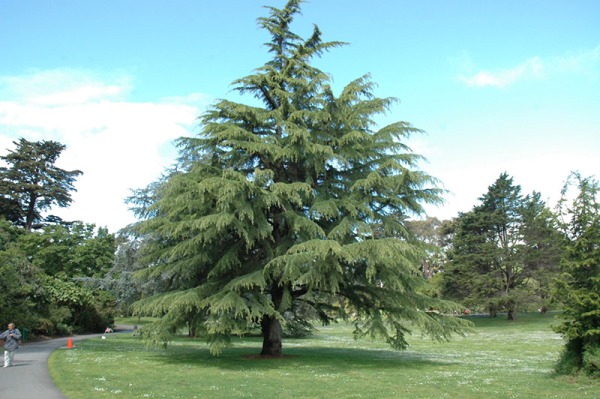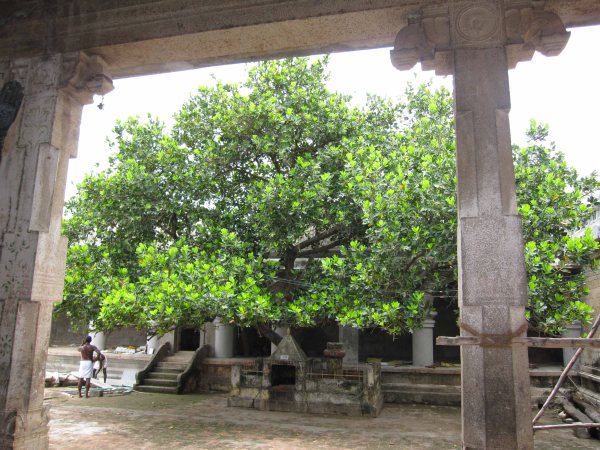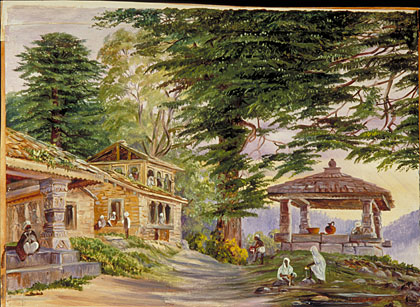
Picture of Deodar: Tree of the Gods
We have heard about people adopting children. But the greatest of the Indian poets Kalidasa and Sangam Tamil poets give some interesting information about adoption (Sweekar) of trees. Lord Shiva adopted a Devadaru Tree according to Kalidasa. A Tamil woman adopted a Punnai tree and watered it with milk and honey according to 2000 year old Sangam literature!
Love towards animals is known throughout the world. But love towards plants is rarer in literature. Kalidasa in Raguvamasa says (II-36-39):
‘’Look at that Devadaru tree. Shiva considered this tree as his son. Parvati also waters it with water from golden pots like she gave milk to her son Kartikeya (from her breast). The tree is compared to Subramanya. Once a wild elephant scratched its temple against it and destroyed its bark. Parvati grieved for it as if her son Subramanya was injured by the missiles of demons’’.
It looks like Kalidasa liked trees very much. In his Megadutam verse 74 also he says:
‘’Close by grows a young Mandara tree
Nurtured by my love like son and now bending
With clusters of blossoms
Within reach of her hand’’.
This is echoed in Natrinai verse 172 (see below).
Kalidasa’s most famous drama ‘Sakuntalam’ has more references to love towards plants and animals. ‘I love them like a sister’,says Sakuntala (I-17),pointing to plants. Sakuntala even named her favourite jasmine plant as ‘Vana Jyotsni’(I-20). In another place Sakuntala’s girl friend says, ‘’Look, Sakuntala, here is Madhavi bush. Father Kanva nurtured with his own hands as he nurtured you. Sakuntala refers to plants and deer as sisters in more than three places.
In Kumara Sambhava Kavya (II-55), Kalidasa advocates tree protection. The poet says, ‘’Even a poisonous tree is not cut off’’. Tamils also echo this by saying, ‘’Even a tree with medicinal properties is not fully destroyed’’ in Natrinai verse 226 by Kani Pun Kundranar. Sakuntalam has a proverb: Can anyone water a jasmine creeper with hot water?’(Sakuntalam IV-1)

Picture of Punnai Tree
Tamils adopt Trees
Tamil Sangam literature has a similar episode in Natrinai verse 172:
‘’Do you remember? When we were young we were playing with Punnai seeds and left one forgetfully under the soil. It grew up big and we watered it with milk mixed with honey. When it became a tree, your mum commented ‘Oh this Punnai tree is better than you. It is like your sister’. Now I feel shy to date my lover under the tree’’.
Since the girl considered the tree as her own sister, she refused to date her lover under the tree. What a great poem! She truly believed her sister is watching. Ancient Hindu girls didn’t date boys in front of others, particularly relatives. Tamil poems even advocate to ‘Do sex like crows’, which is never seen by the public.
A Tamil saint of our times Vallalar Ramalinga Swami said in a song that he withered whenever he saw a withered plant. This was an echo of 2000 year old literature. In Natrinai verse 230, a simile is used by a poet: ‘’I feel (happy) like a withered plant getting water’’.
The best examples are in Tamil in the stories of Pari and Bekan. They are among the Last Seven Philanthropists (Kadai Ezu Vallalkal). Pari gave his chariot to a Jasmine creeper when he saw it fluttering in wind without any support. Bekan gave his royal shawl to a peacock when it danced spreading its feathers. He thought it was shivering in cold! Love is blind!
There are innumerable references in Tamil and Sanskrit where the poets greet the plants, because something good happened. There are hundreds of references about the reactions of plants and animals when good and bad things happened.
Whenever a king visited a sage or saint inside the forest, he always stationed his army at a distance. The reason given for it in Raguvamsa (11-52) was to avoid the destruction of forests. They showed so much concern for environment.
Trees are worshipped by the Hindus. Peepul tree ,banyan tree and fig tree—all the three trees of the Ficus genus (asvatta, Vata and Udembara) are worshipped by the Hindus. Vishnu Sahasranama also praised the three trees.

Painting from Kew Gradens, London showing deodars.
Please read my earlier posts on Kalidasa:
1.Gem stones in Kalidasa and Tamil Sangam Literature
2.Holy River Ganges in Kalidasa and Sangam Tamil Literature
3.Gajalakshmi in Kalidasa and Sangam Tamil Literature
4.Sea in Kalidasa and Sangam Tamil Literature
5. Bird Migration in Kalidasa and Tamil literature
6.Hindu Vahanas in Kalidasa and tamil literature
7.Amazing Statistics on Kalidasa
8.Kalidasa’s age: Tamil works confirm 1[SUP]st[/SUP] Century BC
9.சங்கத்தமிழ் இலக்கியத்தில் காளிதாசன் உவமைகள்
10. காளிதாசனின் னூதன் உத்திகள்: தமிழிலும் உண்டு
